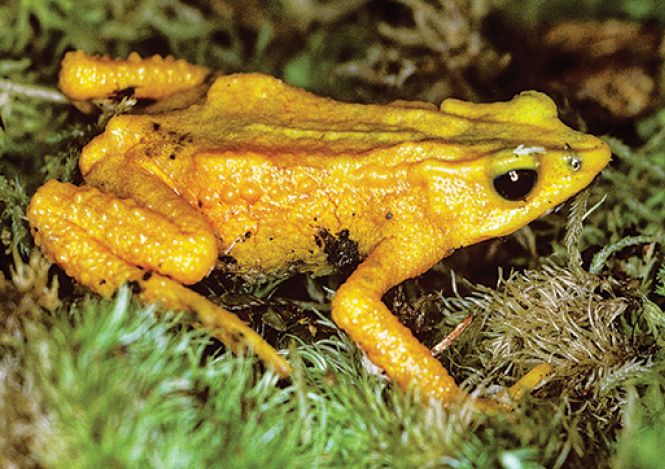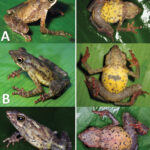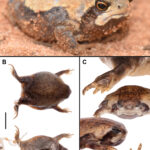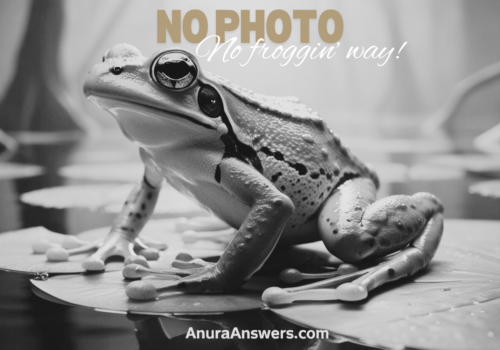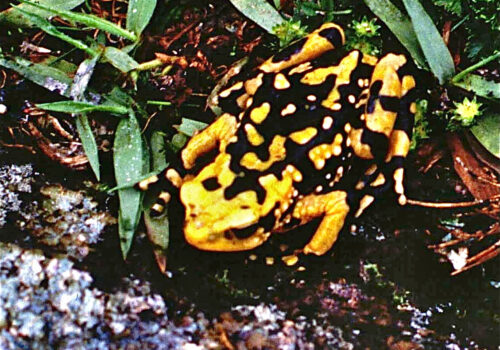Atelopus oxyrhynchus: Exploring the Enigmatic Sharp-Snouted Harlequin Frog#
Hidden among the vibrant foliage of South America’s cloud forests lives a tiny treasure, a creature of striking beauty and intriguing survival skills: the Sharp-Snouted Harlequin Frog, scientifically known as Atelopus oxyrhynchus. With its vivid coloration and slender form, this remarkable amphibian captivates nature lovers and biologists alike, yet remains cloaked in mystery due to its elusive lifestyle and dwindling numbers.
This beautiful yet imperiled species belongs to the Bufonidae family—a diverse and widespread group of amphibians commonly referred to as true toads. However, Atelopus oxyrhynchus does not quite fit the typical stereotype of a toad. Its dazzling hues, peculiar habits, and unique ecological niche set it apart, providing a fascinating subject for researchers, conservationists, and general wildlife enthusiasts eager to learn more about the hidden connections shaping life in tropical forests.
Perhaps most intriguing is what this tiny frog represents. Like other harlequin frogs, Atelopus oxyrhynchus serves as a canary in the coal mine—a biological messenger warning us of subtle ecological disturbances. In its very survival lies an indispensable message about biodiversity, human impacts, and the urgent importance of conservation efforts.
Taxonomy and Classification#
Atelopus oxyrhynchus belongs to the amphibian family Bufonidae, commonly known as true toads. While boasting numerous cousins across the broader Bufonidae family, this particular species is neatly housed within the genus Atelopus, famed globally for brightly colored species frequently referred to as harlequin frogs or harlequin toads.
The genus Atelopus itself contains dozens of closely related species—most notably known for their extraordinary diversity of colors and patterns. Within this vibrant family, Atelopus oxyrhynchus, also commonly known as the Sharp-Snouted Harlequin Frog, is characterized by its distinctively acute snout. Its Latin species name—oxyrhynchus, meaning “sharp-snouted”—aptly describes this prominent facial feature.
Natural Habitat#
Atelopus oxyrhynchus primarily inhabits the lush forests and high-altitude cloud forests along the eastern Andean slopes of South America, particularly documented in countries such as Venezuela and adjacent regions in neighboring Colombia. For millions of years, these forests have echoed with amphibian calls, and within this ancient environment, the Sharp-Snouted Harlequin Frog has carved its ecological niche.
This species favors pristine mountain habitats dominated by cloud forests—places where mist envelops the canopies and moisture continuously drips from leaf edges to nourish a richly diverse understory. In these lush havens, the frog makes its home near fast-flowing mountain streams or cascading forest rivulets, both essential for breeding and tadpole development.
Here, the air remains perpetually humid, cool, and saturated with moisture, creating the perfect microclimate for amphibians like Atelopus oxyrhynchus. Shaded by towering trees draped in lush epiphytes, ferns, and mosses, this species flourishes within the organically rich layers along rocky stream sides, expertly camouflaged among leaves and roots. Such conditions not only support the frogs’ daily activities but also maintain ideal spawning grounds needed to ensure their reproductive success.
Physical Characteristics#
Atelopus oxyrhynchus is a relatively diminutive amphibian, typically measuring between 2 to 4 centimeters in length—about the size of a human thumb. But what the frog lacks in stature, it makes up for with striking aesthetics. Its elongated body shape culminates in a sharply pointed snout, creating the distinctive appearance that justifies its evocative common and species names.
Its myriad coloration is perhaps its most distinctive lesson in visual artistry. Typically adorned with vivid hues ranging from lime green, mustard yellow, and vibrant oranges to deep black markings, the Sharp-Snouted Harlequin Frog is truly an amphibian masterpiece. These bold, contrasting colors serve as aposematic warnings—a clear biological signal to potential predators that this tiny amphibian harbors potent toxins beneath its deceptively delicate skin.
The frog’s skin, smooth yet subtly textured, secretes alkaloid compounds as a form of chemical defense. In nature, vivid patterns and palettes frequently signify danger, and this species’ bright warnings are integral to its very survival, keeping predators at bay and ensuring uninterrupted days spent hopping gracefully along mossy banks.
Behavior and Life Cycle#
Feeding Habits and Daily Life#
The diet of the Sharp-Snouted Harlequin Frog primarily consists of small invertebrate prey that thrives within moist leaf litter and forest floor substances. Their choice fare includes insects such as ants, small beetles, mites, and other tiny arthropods they actively seek beneath moist organic debris. Hunting occurs predominantly during the day—a behavioral trait fitting a bold creature who hides in plain sight, trusting confidently in its powerful chemical defense.
Remarkably agile and accurately observant, the frog employs stealth and patience, sitting motionless for extended periods before swiftly darting its sticky tongue toward an unsuspecting insect, securing its nutritious prize in split seconds. Their sharp snout, unobtrusive limbs, and slender profile also allow them to thoroughly explore gaps and crevices among foliage, roots, and rocks in their relentless search for nourishment.
Mating and Reproduction#
Reproduction happens annually, usually triggered by the onset of seasonal rains, which also rejuvenates mountain streams. Males congregate in specific breeding sites along watercourses, perching on streamside vegetation or rocks, calling with soft but slightly resonant vocalizations to attract females. Though not as exuberantly vocal as many tropical frogs, their charm comes in quieter songs that blend easily with cascading water sounds—a delicate communion between frogs and nature.
Once paired, the female deposits gelatinous masses of eggs attached to underwater stones or vegetation in gently flowing waters. These small egg clusters eventually hatch into tadpoles, specialized to cling tenaciously to submerged rocks to resist the relentless current. Rapidly growing and developing, these tadpoles soon metamorphose into miniature versions of their parents, brilliant colors gradually intensifying as they mature, proudly serving notice of their potent chemicals beneath luminous skin.
Ecological Role#
The Sharp-Snouted Harlequin Frog occupies an indispensable ecological niche within the cloud forest habitats it calls home, acting both as predator and prey. It maintains balance in invertebrate populations, helping control insect abundance and ensuring ecosystem equilibrium.
Furthermore, its strong toxicity notwithstanding, several specialized predators, including some snake species and carefully adapted birds, find this frog tolerable, if sparingly. The frog forms an essential link within food webs, creating interactions that intertwine biology, chemistry, and behaviors across multiple complex forest communities.
Perhaps most significantly, harlequin frogs such as Atelopus oxyrhynchus aid as critical ecological indicators. Sensitive to environmental changes, thriving populations signal a balanced habitat and stable ecosystem dynamics. Conversely, population declines vividly illustrate disruptions within their delicate cloud forest ecosystems, making them irreplaceable biological sentinels.
Threats and Conservation Status#
Sadly, habitat degradation, climate change, pollution, and particularly the devastating fungal disease chytridiomycosis severely threaten harlequin frogs. The International Union for Conservation of Nature (IUCN) currently classifies Atelopus oxyrhynchus as Critically Endangered, a stark representation of its ongoing plight.
Dedicated conservation groups, research teams, and wildlife authorities tirelessly attempt to reverse population declines through habitat restoration projects, captive breeding programs, disease treatment research initiatives, and awareness campaigns. But the fragility of these amphibians demands global attention and collective conservation action.
Cultural and Scientific Significance#
Historically, indigenous communities in the Andes have recognized the symbolic importance of brightly colored amphibians like the Sharp-Snouted Harlequin Frog, often associating them with rain, purity, fertility, and ecological wellbeing.
Scientists too have discovered remarkable insights via harlequin frogs, utilizing their unique toxins in medical research, ecological studies, and in drawing attention to climate-driven biodiversity crises.
Conclusion#
Today, more than ever before, the delicate survival of Atelopus oxyrhynchus speaks volumes about humanity’s responsibility towards nature’s diversity. To protect this mysterious and enchanting creature is to protect our shared heritage, biodiversity, and health. We must step forward collectively, help restore critical habitats, and raise voices advocating the preservation of this vibrant wonder of nature—a tiny, sharp-snouted guardian of our shared ecological future.

